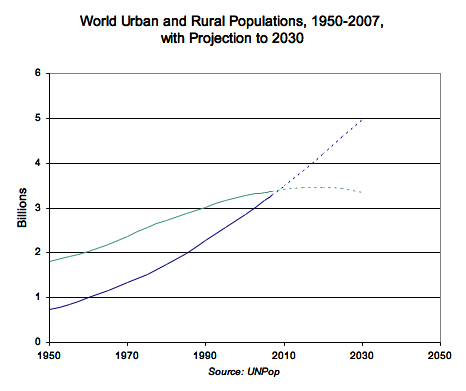“A great book which should wake up humankind!” –Klaus Schwab, World Economic Forum
Lester Brown’s new book, Plan B 4.0: Mobilizing to Save Civilization, will be released on September 30, 2009. Behind the scenes supporting the book’s text are hundreds of datasets, studies, and reports. Today Earth Policy Institute is offering a sneak peak at some of the data for Chapter 6: Designing Cities for People.
What you can glean from these charts and graphs:
There are now more than 6.7 billion people living on the planet.
For the first time in 2008 the world’s city dwellers outnumbered those in the countryside. The share of urbanites is projected to continue increasing, so that by 2030 some 60 percent of the world’s population will live in cities.

In 1950 the world had only two “mega-cities” with over 10 million inhabitants: Tokyo and New York. These two are still the world’s largest, with 36 million and 19 million people in their respective metropolitan areas. Since 1950, 17 others have joined the “mega-city” list; notably Mexico City, Mumbai (Bombay), São Paulo, Delhi, and Shanghai each are home to more than 15 million people. Dhaka, Bangladesh, had one of the fastest growth spurts, its population ballooning more than 40-fold since 1950.
In the 1950s the world produced almost as many cars as it did bicycles—close to 10 million units each. Since then, automobile production has increased 6-fold while bicycle production has grown 12-fold.
Vehicle sales in Japan peaked in 1990 at 7.8 million units. Since then sales have fallen almost every year, with 2009 sales projected at 4.9 million units. Support for public transportation and bicycling is high.
In an attempt to reduce traffic congestion and air pollution and to improve overall mobility, London instituted a charge on vehicles entering the city center in early 2003. By 2007, trips into the city by personal automobile dropped 36 percent while those by bus increased 31 percent and those by bicycle increased 66 percent.
These are just some of the information tidbits you can find in the Plan B 4.0 datasets. Stay tuned for more at Earth Policy Institute’s freshly redesigned website, www.earthpolicy.org!


 Print:
Print: 

